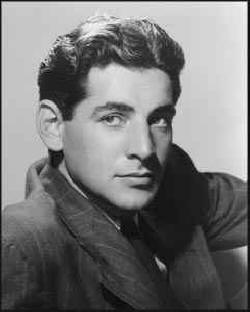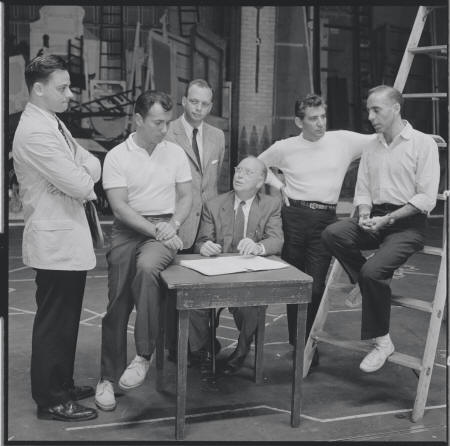

Partner Tom Cothran
Queer Places:
Boston Latin School, 78 Avenue Louis Pasteur, Boston, MA 02115, Stati Uniti
Harvard University (Ivy League), 2 Kirkland St, Cambridge, MA 02138
Brandeis University, 415 South St, Waltham, MA 02453, Stati Uniti
Yaddo, 312 Union Ave, Saratoga Springs, NY 12866, Stati Uniti
Curtis Institute of Music, 1726 Locust St, Philadelphia, PA 19103, Stati Uniti
Fontainebleau Schools, 77300 Fontainebleau, Francia
MacDowell Colony, 100 High St, Peterborough, NH 03458
32 W 10th St, New York, NY 10011
Dakota Apartments, 1 W 72nd St, New York, NY 10023, Stati Uniti
Green-Wood Cemetery, 500 25th St, Brooklyn, NY 11232, Stati Uniti
 Leonard
Bernstein (August 25, 1918 – October 14, 1990) was an American
composer,
conductor, author, music lecturer, and pianist. He was among the first
conductors born and educated in the US to receive worldwide acclaim. According
to music critic
Donal Henahan, he was "one of the most prodigiously talented and
successful musicians in American history."[2]
Leonard
Bernstein (August 25, 1918 – October 14, 1990) was an American
composer,
conductor, author, music lecturer, and pianist. He was among the first
conductors born and educated in the US to receive worldwide acclaim. According
to music critic
Donal Henahan, he was "one of the most prodigiously talented and
successful musicians in American history."[2]
Addressing the post-WWI period in his enormous overview of twentieth-century music, but without the ulterior agenda of the anti-gay conspiracy theorists, Alex Ross writes: Homosexual men, who make up approximately 3 to 5 percent of the general population, have played a disproportionately large role in composition of the last hundred years. Somewhere around half of the major American composers of the twentieth century seem to have been homosexual or bisexual: Aaron Copland, Virgil Thomson, Leonard Bernstein, Samuel Barber, Marc Blitzstein, John Cage, Harry Partch, Henry Cowell, Lou Harrison, Gian Carlo Menotti, David Diamond, and Ned Rorem, among many others.
Bernstein's fame derived from his long tenure as the music director of the New York Philharmonic, from his conducting of concerts with most of the world's leading orchestras, and from his music for West Side Story, Peter Pan,[3] Candide, Wonderful Town, On the Town, On the Waterfront, his Mass, and a range of other compositions, including three symphonies and many shorter chamber and solo works.
Jerome Robbins had an intimate relationship during the 1940s with Fancy Free's scene designer, Oliver Smith. Although details are limited, suggestive traces exist. In the notebook of ideas for Fancy Free where Robbins lists possible composers, he mentions Smith on one page, simply naming him. Another page features a drawing of a nude male dancer, in midleap and with an erection. An arrow from the initials J.R. (written upside down) points to the drawing. A separate document—a letter from Smith to "Jerry" dated August 8, 1944—chronicles their romantic involvement several months after the ballet's premiere. The opening paragraph is unambiguously addressed to a romantic partner, with sexual references and direct affirmation of being in love. The rest of the letter migrates between romantic gestures and details of "a layout for the show," which at that point meant On the Town. Greg Lawrence, a biographer of Robbins, speculates that Robbins had affairs with John Kriza and Harold Lang while Fancy Free was emerging. In interviews with Lawrence, various dancers associated with Ballet Theatre attested to these romances, although many were sharing hunches. Kriza was "the real love of Jerry's life then," asserted dancer Shaun O'Brien, and Lawrence quotes others who also believed that Kriza and Robbins had an affair. Janet Reed inserted Harold Lang into the mix, recalling that he was bisexual and suggesting that a romantic tie to Robbins would have been strategic. "Lang was very ambitious," Reed stated, "and it seemed to me that any homosexual relationship he had was for getting ahead. But Jerry didn't have anything to gain, whereas Lang and Kriza had everything to gain from him." Fellow dancers also suspected a romantic relationship between Robbins and Leonard Bernstein. "They had a kind of brief encounter," declared the dancer Richard D'Arcy, "an affair just in that early period when they were doing Fancy Free." D'Arcy believed it happened "when the score was being written."

West Side Story creative team From left to right: Stephen Sondheim (lyrics), Arthur Laurents (book), Hal Prince (producer), Robert E. Griffith (producer), Leonard Bernstein (music), and Jerome Robbins (director).
Dakota Apartments, 1 W 72nd St, New York, NY 10023, Stati Uniti
Osborne Apartments, 205 W. 57th St., New York, NY 10019
Bernstein was the first conductor to give a series of television lectures on classical music, starting in 1954 and continuing until his death. He was a skilled pianist,[4] often conducting piano concertos from the keyboard. He was also a critical figure in the modern revival of the music of Gustav Mahler, the composer he was most passionately interested in.[5]
As a composer he wrote in many styles encompassing symphonic and orchestral music, ballet, film and theatre music, choral works, opera, chamber music and pieces for the piano. Many of his works are regularly performed around the world, although none has matched the tremendous popular and critical success of West Side Story. All major figures involved in creating this piece - Bernstein, Stephen Sondheim, Jerome Robbins, Arthur Laurents, and Jean Rosenthal - were gay.
Bernstein's Symphony no. 2 is based on W.H. Auden's poem The Age of Anxiety. Bernstein also set to music poems by Walt Whitman, Gertrude Stein and Langston Hughes in Songfest.
After much personal struggle and a turbulent on-off engagement, he married the Chilean-born American actress Felicia Cohn Montealegre on September 10, 1951. One suggestion is that he chose to marry partly to dispel rumors about his private life to help secure a major conducting appointment, following advice from his mentor Dimitri Mitropoulos about the conservative nature of orchestra boards.[34] In a book released in October 2013, The Leonard Bernstein Letters, his wife reveals his homosexuality. Felicia writes: "you are a homosexual and may never change—you don’t admit to the possibility of a double life, but if your peace of mind, your health, your whole nervous system depend on a certain sexual pattern what can you do?" Arthur Laurents (Bernstein's collaborator in West Side Story) said that Bernstein was "a gay man who got married. He wasn't conflicted about it at all. He was just gay."[42] Shirley Rhoades Perle, another friend of Bernstein, said that she thought "he required men sexually and women emotionally."[43] But the early years of his marriage seem to have been happy, and no one has suggested Bernstein and his wife didn't love each other. They had three children, Jamie, Alexander, and later Nina.[44] There are reports, though, that Bernstein did sometimes have brief extramarital liaisons with young men, which several family friends have said his wife knew about.[43]
A major period of upheaval in Bernstein's personal life began in 1976 when he decided that he could no longer conceal his homosexuality and he left his wife Felicia for a period to live with the musical director of the classical music radio station KKHI-FM in San Francisco, Tom Cothran, whom he had met in 1971.[45] The next year she was diagnosed with lung cancer and eventually Bernstein moved back in with her and cared for her until she died on June 16, 1978.[34] Bernstein is reported to have often spoken of his terrible guilt over his wife's death.[34] Most biographies of Bernstein state that his lifestyle became more excessive and his personal behavior sometimes cruder after her death. However, his public standing and many of his close friendships appear to have remained unaffected, and he resumed his busy schedule of musical activity.
When Mark Taylor, his last lover, asked Bernstein if he had loved his wife passionately, he replied, "Everyone I love, I love passionately." In his friends and acquaintances Aaron Copland, David Diamond, Ned Rorem, Gian Carlo Menotti, Samuel Barber, and Benjamin Britten he had clear role models, serious composers who lived relatively open and happy as gay men. When Bernstein urged an aging Aaron Copland to come out, Copland replied: "I think I'll leave that to you, boy."[3]
Bernstein announced his retirement from conducting on October 9, 1990,[46] and died at his apartment at The Dakota of a heart attack five days later, brought on by mesothelioma.[47] He was 72 years old.[2] A longtime heavy smoker, he had battled emphysema from his mid-50s. On the day of his funeral procession through the streets of Manhattan, construction workers removed their hats and waved, calling out "Goodbye, Lenny."[48] Bernstein is buried in Green-Wood Cemetery, Brooklyn, New York,[49] next to his wife and with a copy of Mahler's Fifth Symphony lying across his heart.[50]
My published books: